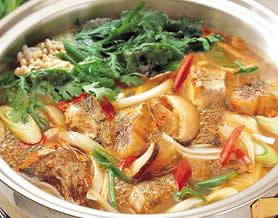Ok, it admit it. I'm kinda starting to hit a slump here, literally. I am really tired at the moment. Friends came over today and we made our costumes for this things next week. Anyways, because I am really tired, I'm just going to post a quick post. I'll try and post more tomorrow.
So today I'm not posting a rice dish. It is a noodle dish. Today I will be introducing you to Spicy Seafood Noodle or Jjam Ppong (짬뽕). This is pretty much noodles in a seafood broth. This is a dish similar to jajangmyeon which also has origins from China.
"Jjamppong is a popular noodle dish that is prepared in a red, spicy seafood broth containing hearty vegetables and variety of seafood. This dish presumably has its origins in Japan with influence from China and is known to be very popular at various restaurants or even at homes. Instant noodle versions are also popular which can be prepared within minutes.
However, to enjoy this authentic dish, many Koreans go to Korean/Chinese restaurants where noodles are mixed in with real seafood such as squids, shrimps, clams and scallions. Fresh vegetables such as onions, red peppers, green onions as well as many others are included in this dish to compliment the spiciness of the base soup. Jjampong is considered to be mild to high in spiciness so expect to sweat while consuming this dish."
That is a description of the dish, and a bit about it's history. Now, on to it's recipe:
Ingredients
1 package fresh egg noodles
½ cup pork, thinly sliced
½ cup squid, cleaned and thinly sliced
8 small shrimp, peeled and deveined
6 mussels, scrubbed
5 dried black mushrooms
½ onion sliced
½ carrot, cut into match-stick pieces
¼ napa cabbage, cut into 1x2 in pieces
2 green onions, cut into 2 inch pieces
2 red chili peppers, seeded and sliced
1 tsp ginger, minced
1 tsp garlic, minced
2 tbsp olive oil
7 cups chicken broth
2 tbsp soy sauce
Salt & pepper to taste
½ tbsp gochugaru (red chili pepper flakes - optional for spiciness)
Method
1. Soak mushrooms in warm water and cover for 30 minutes. Drain. Slice and set aside.
2. Bring mussels and water to a boil in a pot. Cover, reduce heat to low, and cook for 5 minutes or until the shells open. Lift out mussels and set aside. Retain liquid and add 7 cups of chicken broth.
3. In a large pot of boiling water, cook noodles according to package directions until tender but firm to the bite. Drain well and set aside.
4. Add olive oil to a wok or frying pan.
5. Add garlic and ginger and cook, stirring, until fragrant, about 5 seconds. For spicier taste, add gochugaru.
6. Add pork, shrimp, squid, mussels, and stir-fry.
7. Add onions, carrots, red chili pepper, and green onions and stir-fry.
8. Add cabbage and chicken broth mixture and bring to a boil. Reduce heat to med-low and let simmer.
9. Add soy sauce.
10. Add salt & pepper to taste.
11. Place noodles in a large soup bowl and pour hot soup mixture over noodles
And there you have it. A delicious hearty seafood meal, you is going to warm you up in this cold weather.


That is it from me today. Until tomorrow remember to stay healthy and happy. See you tomorrow.

